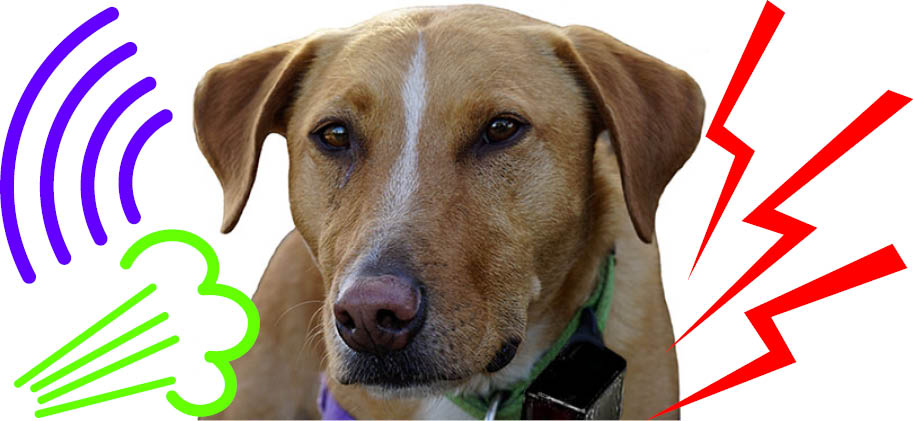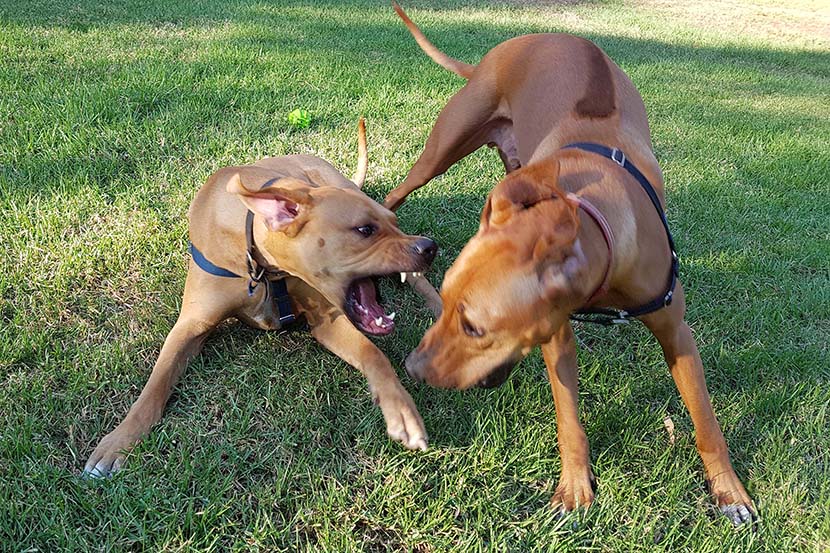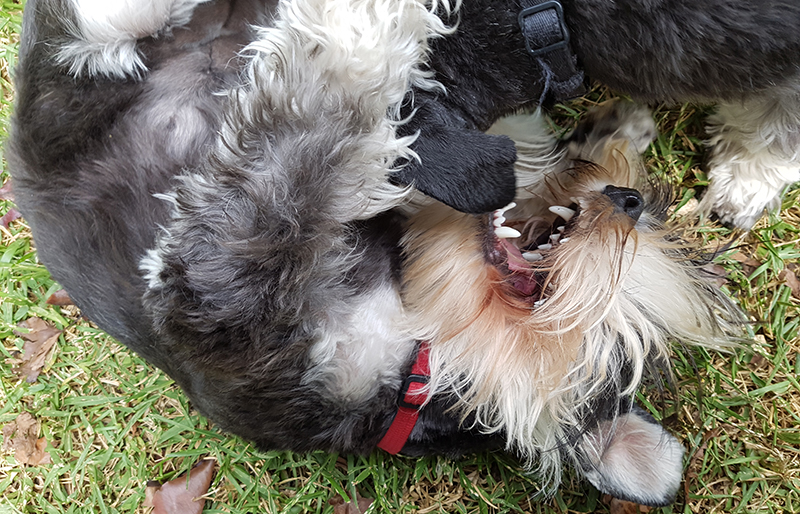So-called “anti-bark collars” aim to silence a dog’s voice by delivering electricity, odours or ultrasonic sound to the dog’s senses. The use of these devices can have serious short- and long-term welfare implications for the dog, so why do dog-loving people use them?
Deceptive Marketing
Across the bench, the language used to promote anti-bark collars and similar devices is misleading, presumably to dispel any lingering doubts a potential customer might have. Apparently, people do have doubts about these gadgets and rightly so. But instead of properly addressing those doubts and being clear about possible side-effects, the product descriptions are full of meaningless labels.
Undisclosed Fact: Anti-Bark Collars Aim to Silence Your Dog Via “Positive Punishment”—A Method Which Is Neither Safe nor Humane
The marketers are at pains to ensure you that the devices are
“safe”, “harmless”, “gentle”, “without pain or fear” and “humane”.
and their modus operandi is a benign
“correction”, “vibration” or “stimulation”.
Despite this lack of unpleasantries, the collars are obviously designed to stop your dog from barking, so we are made to believe that a
“safe static correction“, a “gentle, yet effective, spray”, a “spray of harmless citronella” or a “harmless but effective ultrasonic sound”
can do just that.
Of course, all of this sounds a lot better than naming the actual process behind the reduction in barking. We can’t know how the dog feels about whatever “stimulation” they receive, but if it does indeed lead to less barking in the future, then the correct term for the process of how this was achieved is punishment (or more correctly: positive punishment—more on that below).
Putting the word punishment on the product description isn’t so good for sales, I would assume. But, more importantly, naming the exact mode of behaviour modification by which those collars operate would call for full disclosure regarding the known risks associated with it.
Undisclosed Fact: Your Dog Always Barks for A Reason and May Not Be Able to Just Stop
The companies also want to assure you that your dog’s barking is
“unnecessary”, “excessive” and a “nuisance”.
Thus, the use of anti-bark collars is completely justified, because—clearly—your dog barks for no reason and way more than they should. So, it’s perfectly fine to give a them a “reminder” to turn their annoying barking off. Nothing wrong with a little zap to zip it, right?
But, who makes that call? Who decides, if or when your dog’s behaviour is unnecessary or excessive?
Where in the product description is the suggestion to consult with a qualified canine behaviour expert to identify why the dog is barking in the first place?
Dogs do not bark “unnecessarily” or “at nothing” or “for no reason”. Just because the reason isn’t obvious to us, doesn’t mean there isn’t one. Proponents of anti-bark collars want us to ignore this. They try to make us believe that our dogs are not normally functioning biologically beings but rather something we can turn off on a whim, like an annoying TV commercial.
Rounding up the sales pitch are often entirely inappropriate qualifiers such as
“deluxe”, “attractive” and “exclusive”
to cause further distraction from exactly how these devices work. More glitter thrown into your eyes.
Anti-Bark Collars Need to Come with A Risk Statement Until A Total Ban Is in Place
Maybe the product descriptions were written by people in the marketing department who are more accustomed to selling the latest lifestyle gadgets or fashion accessories. Advertising a product that aims to change the behaviour of a living organism is a whole different ball game. It requires disclosure about exactly what will happen to the individual who is exposed to the device and how this will affect their short- and long-term behaviour and well-being.
Positive punishment—which is what all these collars rely on—has known risks, and everyone who considers buying these products needs to be made aware of it. Add to that the risk of leaving your dog alone with a device around their neck that can not only malfunction but function in a manner you did not expect.
What we need clearly displayed on anti-bark collars (and related devices, such as electric fences) are risk statements, similar to what we see on cigarette packs. Better yet: Let’s just ban all of these contraptions and stand shoulder to shoulder with other progressive countries that have already done so, instead of being the laggards.
The Risks Associated with Anti-Bark Collars
The science of Animal Learning and Behaviour tells us that behaviour is controlled by environmental conditions (external and internal). So, a dog’s barking might be triggered by the neighbour’s children playing in their yard, a noisy truck rumbling past the property, a hot air balloon flying over, a burglar breaking into your house or because the dog is in pain or suffers from fear or loneliness. Internal conditions are impossible for us to fully understand but we can detect them by watching the dog’s behaviour and body language.
In addition to triggers, behaviour is also controlled by consequences: A behaviour is likely to occur more often in the future, if it leads to favourable outcomes for the animal (reinforcement), and less often, if the results are not so good (punishment).
Anti-bark collars operate via positive punishment (adding something to the dog’s environment to reduce the behaviour of barking). Punishment can be a very effective way to reduce behaviour, so what’s so bad about it?
Aversive Consequences Can Create Negative Associations with Any Trigger Or Anything In The Environment
The timing and “clean” execution of positive punishment may be easy enough in a laboratory, but there is no guarantee your dog won’t form unintended associations when they receive the shock, spray or sound from the anti-bark collar. Anything that the dog may hear, see, smell or otherwise perceive at that time may become associated with the negative experience. The neighbour’s kids, the cat on the fence, a hot air balloon flying over—anything. Now the dog feels even more motivated to bark when confronted with those elements in the future. Anxious and aggressive behaviour can easily follow.
Aversive Consequences Can Cause Apathy, Anxiety And Aggression
Attempting to block or suppress an individual’s behaviour by providing aversive consequences has known risks. Dogs who are happy and confident may become anxious, apathetic or aggressive following the use of anti-bark collars. This can manifest itself only in certain contexts or it can generalise and affect the dog’s behaviour in other situations. The frightening part is that dogs who show less behaviour overall, i.e. dogs who become less active or even apathetic, are often labelled “well-behaved” dogs. But a decrease in overall behaviour is not a sign of being well. It’s a sign of being mentally or physically ill.
For dogs who bark out of anxiety, for example those who suffer from separation anxiety or noise phobias, the use of aversive consequences can be particularly catastrophic. The collars simply heap more nightmarish experiences onto the dog’s already troubled mind.
When an individual is at the mercy of forces they cannot control, their quality of life is seriously compromised.
The Well-Being of Beings Is All About Control
It may seem the use of an anti-bark collar means giving your dog a choice: “Shut up or suffer the consequences. It’s up to you!” But, the dog may not have such easy control over their barking, and even if they do, how does it affect their emotional health, if they can’t speak up anymore?
There Is No Joy In Confusion And Frustration
Let’s imagine you attend a show by one of your favourite comedians—the type that makes people laugh so hard that their bellies ache and their eyes water. But soon you realize that something is wrong. Every time you laugh out loud, a bug that is stuck deep down in your ear starts buzzing. When you stop laughing, the buzzing stops. You have no way of removing the bug from your ear or squashing it. You try to suppress your laughter to avoid the annoying buzz, but the comedian is just so darn funny, you can’t help but burst out laughing. Would that drive you mad?
It depends. Maybe you get used to it after a while and keep laughing out loud. Or maybe it is so frustrating or even painful that you leave the show, see a doctor and get that buzzing bug out of your ear. Lucky you for being able to seek help.
And Then There is Only Panic
Now assume you get yourself trapped in a secret room in a medieval castle and no one knows you’re there. You yell out for help when all of a sudden a high-pitched sound causes a sharp pain in your ears. You are momentarily confused why your cries for help would seem to trigger this ear piercing tone, but your intense fear to be forgotten and die a slow and horrible death in this room is overwhelming. So, you keep screaming at the top of your lungs despite the pain in your ears and you bang on the door until your hands bleed. Finally, with your voice failing, your ears pounding and your fingers broken, you realise that no one is coming to rescue you. You are all alone.
Hopefully, by that time you wake up and realise it was all just a bad dream. Lucky you.
If the latter scenario sounds fantastically dramatic, just think: How panic stricken does someone have to be to mutilate their own body? Separation anxiety can do that to a dog. They do not bark for no reason. They are screaming for help.
No matter, if your dog barks out of joy or concern, to talk to other dogs in the neighbourhood, raise the alarm or cry for help, it is a valid expression of their personality and their state of mind. If we simply put a lid on it, we may do a lot more harm than we ever imagined.
How To Reduce Your Dog’s Barking Without The Fallout
Make Your Dog Feel Safe
If there is any suspicion of separation anxiety, address this right away. This is a welfare issue and any attempts to suppress your dog’s cries for help will only make matters worse. With the help of a vet or behavioural vet and trainers who are experienced in desensitisation protocols for separation anxiety, you can make your dog feel better and remove the reason for their barking.
The same goes for noise phobias or any fear- and anxiety-related problems. Get help so you can help your dog.
Make Your Dog’s Life More Interesting
Lack of stimulation is a problem for most dogs who spend too much time alone, especially when there is not much going on in their lives even when you are home. Taking your dog to the park or for a walk before you go out for the day and leaving them with food puzzle toys rather than feeding from a bowl is a good start. However, depending on your dog’s individual needs, a 10 minute walk around the block and a toy with dry kibble might not cut it. So, find out what activities it takes to make your dog happy and tired. Sports, games, interactive toys, food puzzles and positive reinforcement training are all good options.
Keep Your Dog Inside
Noises in the neighbourhood are often a trigger for barking. If your dog has noise phobias, this is a serious matter which falls into the same category separation anxiety and requires expert help. Even without a strong fear response, your dog might become distressed or highly aroused from exposure to certain noises. Since, unfortunately, you can’t control the world around your home, this means the dog must have access to the house or a place that muffles the outside sounds.
Consider leaving your dog inside while you’re out, at least during certain times when specific neighbourhood noises in your area are more likely to occur. Many dogs do much better when they can sleep inside the house during your absence. There are less distractions and they are less likely to be woken up by noises. Leaving the radio on or a white noise machine can help too.
Combine this with increasing your dog’s physical and mental stimulation and you have a recipe for success. No need for reach for a gadget that promises you quick relief but doesn’t mention the real price you pay.
RESOURCES
Pierce W.D. and Cheney C.D. 2017, Behaviour Analysis and Learning. A Biobehavioral Approach. 6th edn, Routledge, New York




